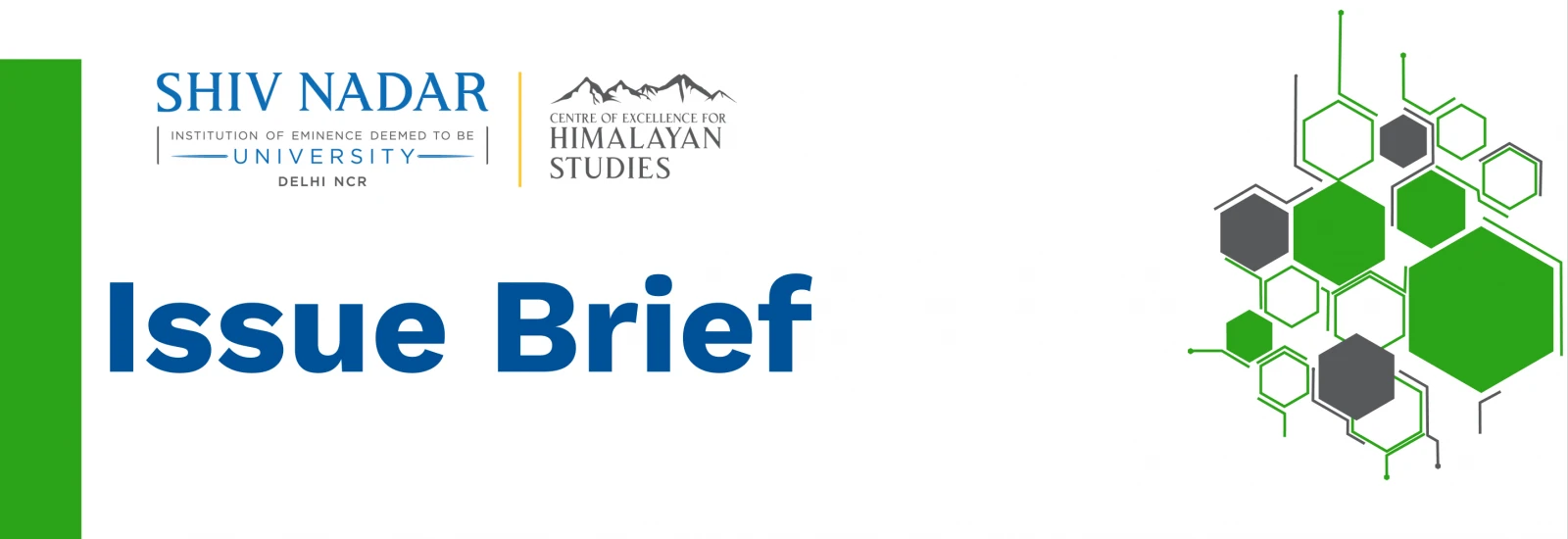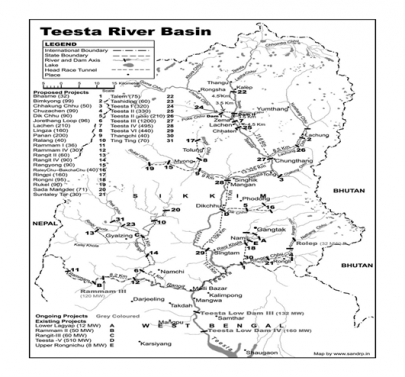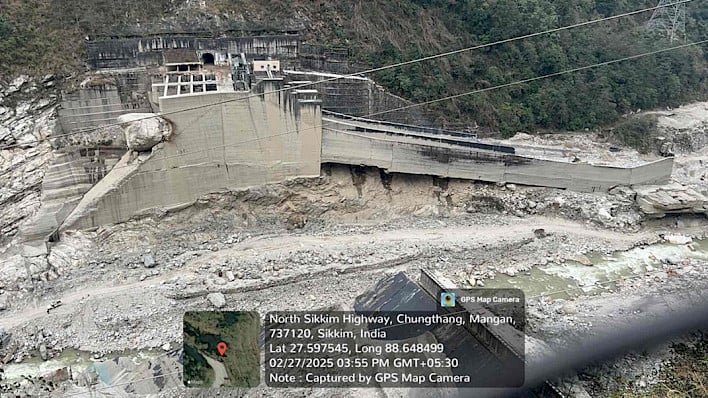
Issue no. 16
August 2025
The Reconstruction of the Teesta Stage III Dam: Understanding Opposition ‘from Below’
Abstract
The Teesta Stage III Hydropower Project is a run-of-river hydropower dam project located in Chungthang in the Mangan District of Sikkim. The Project was commissioned in 2017; however, the dam was swept away by the South Lhonak Lake Glacial Outburst Flood in 2023, causing massive damage to the physical infrastructure and land, and loss of lives. A year after the floods, however, at the beginning of 2025, the Expert Appraisal Committee of the Ministry of Environment, Forest and Climate Change granted environmental clearance for the reconstruction of the Teesta Stage III Dam. This issue brief examines the opposition of the local communities to the planned reconstruction. Through an ethnographic fieldwork and interviews with local community members, it attempts to analyse the dynamics of the links between state-led development, environmental problems, and local contestation in the dam construction in Sikkim and the Himalayan region.
Keywords: Sikkim; Lepchas; border communities; dam-building; economic development; environmental conservation; sacred landscapes
The Teesta Stage III Hydropower Project is one of the many run-of-river hydropower dam projects along the Teesta River in Sikkim (Figure 1). The dam is located at Chungthang town in the northern part of Sikkim, and the river water is diverted through a tunnel before the water is dropped back into the river near Sankalang village, where the powerhouse is located. The South Lhonak Glacial Lake Outburst Flood (GLOF) washed the dam away in 2023.
The Union Ministry of Environment, Forest and Climate Change (MoEFCC) granted the environmental clearance for the rebuilding of the Teesta Stage III Hydro Dam in early 2025 despite opposition from local communities residing in the affected area. The Lepcha community, headed by the Affected Citizens of Teesta (ACT), has opposed the reconstruction of the Teesta Stage III Dam along with other hydropower projects in North Sikkim, contending, among other reasons, that big hydropower dams will impact the sacred landscapes, endangering their culture, identity and spiritual well-being.
This Issue Brief examines the opposition to the reconstruction of the Teesta Stage III Hydropower Project Dam in detail. The opposition to the hydropower dam development in the Himalayan region, in general and in Sikkim, in particular, exhibits the contested nature of dam development in the region. Through ethnographic fieldwork and interviews with the local community members, this study analyses the dynamics of the links between state-led infrastructure development, environmental problems, and local opposition to the dam construction in Sikkim.
Figure No. 1: Map of Projects Proposed for the Teesta River Basin (as of 2008)

Source: South Asian Network on Dams, Rivers and People (2008)
Construction of Hydropower Dams and Contestations in the Himalayas
Dams across the world are concentrated in ecologically-sensitive and culturally-diverse regions such as the Amazon, the Nile, the Mekong River and the Himalayas with sizeable indigenous populations (Coelho and Favaretto 2008; Cole et al. 2014; Grumbine and Pandit 2013). Northeast India, lying in the periphery of the country’s economic development, has been labelled as the country’s ‘future powerhouse’ given its mountainous topography and perennial rivers (Thakur 2023). As such, hydropower projects have been promoted as an important means of meeting energy needs and have been used as a long-term strategic investment in the region. The respective state governments in Northeast India have positioned and pushed for hydropower development. Sikkim was amongst the first states in the region to open its arms for hydropower development (Dukpa et al. 2024; Thakur 2023).
The location of most hydropower dam sites is in isolated, economically marginal and poorly developed frontiers, enabling the state to position hydropower as the main source of revenue to mitigate regional development discrepancies (Huber and Joshi 2015, 13). For example, states justify the construction of big dams citing their positive impact on regional development, job creation and revenue generation (World Commission on Dams 2000, 11). In a mountainous state like Sikkim, industrial development remains challenging and underdeveloped, and so, for the state, investment in hydropower is often an important opportunity to generate revenue and growth. More so, electricity generated by hydropower dams is pushed as a clean and low-cost renewable source of energy.
However, dams as an instrument for “development” come with downsides. Existing research has shown that dam construction follows a top-down approach, in which local communities residing in and around project sites have the least effective say. As a result, anti-dam protests and contestation of claims of benefits are recurring events in many of the dam project sites in the region. The anti-dam movement against the 30 MW Rathong Chu Hydel Project, the 97 MW Tashiding Hydel Project and the Teesta Stage I in Sikkim and the protests against the Subansari Lower Hydropower Project along the Assam-Arunachal stand testament to such conflicts over dam construction in the region.
The opposition by local communities is more than conflicts over water. Rather, it involves questions of what development means, the protection of ecology, livelihood and economy and the destruction of the sacred landscapes. At the core of these contestations by local communities is that the ideas of development among the affected communities clash with those imposed ‘from the above’ (Huber and Joshi 2015, 14).
Figure No. 2: The Damaged Teesta Stage III Dam at Chungthang

Source: Author, 2025
Teesta Stage III Dam: Why Do Local Communities Oppose It?
The opposition to the dam construction in Sikkim goes back to the 1990s, starting with the movement against the 30 MW Rathong Chu Hydel Project (Dukpa et.al 2019, 10). The Affected Citizens of Teesta (ACT), an organisation formed in 2003, has spearheaded the campaign against the dams in North Sikkim . The protest against the Teesta Stage III Project goes back to the early 2000s. Accordingly, when the environmental clearance was issued for the reconstruction of the Teesta Stage III dam in 2025 after the dam was washed away by the South Lhonak GLOF, the ACT had raised concerns over the increase in the height of the dam from 60 metres to 118.64 metres, the absence of any fresh public hearing, and the larger financial burden on the state government of Sikkim. The ACT has also accused the state government, the companies and the financiers of being unaccountable for the violation of the rights of the tribal people. Hence, they have urged the decommissioning of the dam (Sikkim Express 2025).
The Lepcha community’s opposition to the dam in general goes beyond the technical and economic benefits of the project. The Lepcha community’s opposition to dam construction in the region does not entail a denial of the need for development. Rather, its positions rest on a different idea of development altogether.
Cultural Concerns
The foremost concern among the Lepchas is that the dam would inundate land, which is considered a sacred space and hence, cannot be shifted elsewhere (Datta 2020). As the Teesta Stage III Project is a run-of-river project, it diverts the river at Chungthang town through a tunnel before the water is returned to the river near Sankalang village. This leads to the disappearance of the river from its original course, and Lepcha inhabited villages such as Theng, Shipgyer, Naga and Singhik would be impacted by the disappearance of the river. This restricts rituals associated with the river, such as the death ceremony in the Lepcha community. For example, the Rongyoung River (a tributary of the Teesta River) in particular, and the Teesta River, in general, are believed to take the souls back to the foothills of Mount Khanchenzonga, where the souls reside after death. D. Tshering, a resident of Dzongu, argues that if the river is diverted through a tunnel, the soul will be rendered directionless.[i]
The Lepchas consider the affected land by the Teesta Stage III Project, i.e. Dzongu and Chungthang, as a holy land. The myth of their creation and origin is located in the landscapes of Dzongu. As such, the Lepchas have reproduced and symbolised their identity, culture and traditions in many of the sacred landscapes, sacred groves, sacred rivers and sacred lakes in and around the project area. Mayalmit Lepcha, the General Secretary of ACT, points out that the Teesta Stage III Project (including other hydropower projects in and around Dzongu) compromises the sacred landscapes of the Lepcha community, endangering the identity and cultural practices of the community.[ii] For instance, the local fish found in the Teesta River and Rongyoung River and the local birds around the region play a key role as messengers in spreading the words of the Lepcha bonthings (priest). The disappearance of these fish and birds as a result of the Teesta Stage III dam (and other hydropower projects in the region) will have an impact on the religious practices of the Lepcha community.[iii]
Tseten Lepcha of ACT posits that the impact of the multiple power projects on the Teesta River will lead to the disappearance of Lepcha identity and culture, as the history, the ethos, and the folklore of Sikkim are connected with the Teesta.[iv] The construction of the dam as planned will disrupt these established patterns of life and their material and spiritual basis.
Environmental Concerns
Another key source of the contestations over the reconstruction of the Teesta Stage III Hydropower Project is that the environmental clearance following a top-down approach has neglected local voices. The dam, with its massive impact and considerable potential power generation, falls under Schedule A of the river valley projects under the Environmental Impact Assessment Notification of 2006, and it needs environmental clearance from the MoEFCC on the recommendations of an Expert Appraisal Committee (EAC) constituted by the central government. The Project’s decision-making process from the environmental clearance (EIA), planning, construction to operation has, however, followed a centralised and hierarchical process with the central, state government and the Sikkim Urja Limited company playing the major role.
The ACT argues that the process of dam construction and the issuance of the environmental clearance for the Teesta Stage III Hydropower Project (including other projects) has always neglected the views and opinions of the Lepcha community and that the EIA for the Teesta Stage III Project is inadequate. Mayalmit Lepcha contends that the EIA for the Teesta Stage III project and other hydel projects in North Sikkim is flawed,[v] while Gyatso Lepcha, another prominent figure in ACT, laments that the new EIA clearance for the Teesta Stage III dam was issued without any fresh public hearing (Sikkim Express 2025).
Conclusion: A Way Forward
Large-scale dam development provokes strong emotions because it involves questions about the idea of development, of costs and benefits, and ecology. The Teesta Stage III Hydropower Project has, since its inception, been marred by controversy from its perceived excessive initial cost to the larger impact on the local community and environment.
The Project has been largely driven ‘top-down’ in its approach in terms of its environmental clearance, construction and operation. This has inadequately addressed the special needs and vulnerabilities of tribal communities. The rationale for the dam development and the benchmarks for the environmental clearance follow a ‘scientific rationale’ but ignore the perspective of local communities, their worldviews and lifeworld entanglement with nature. The presence of a hierarchy in knowledge and worldviews, where the ‘scientific rationale’ gets privileged over spiritual perspectives of the local communities, leads to conflicts and contestation and the tribal community at loggerheads with the state.
This conflict and contestation of the Lepcha community with the dam project necessitates an alternative view of looking at the nuances of development itself. As such, an alternative perspective which combines the technical and economic benefits with the tribal community’s worldviews is required to make the Teesta Stage III Hydropower Project acceptable and worthwhile to all stakeholders.
The Project needs to achieve consensus by bringing the numerous views of the local community and the state together. Local institutions and associations can be utilised to resolve the contestation as these spaces can act as sites for negotiations, understanding and building mutual understanding. Honest and sincere consultation and discussion with the gram panchayat members and local organisations from the affected areas, from the planning to the operation of the hydropower dams, would help to mitigate misunderstanding. Large development projects require a bottom-up approach where local people also play a key role in shaping objectives and feasibility.
ENDNOTES
- Interview with D. Tshering, 16 April 2025, Gangtok.
- Interview with Mayalmit Lepcha, 16 May 2025, Dzongu.
- Sangay Lachenpa, Fieldnotes, 1 May 2025, Dzongu
- Letter by Tseten Lepcha to Minister for Environment and Forest and National Board of Wildlife. http://www.actsikkim.com/docs/Letter_Jayanti_Natrajan.pdf
- Interview with Mayalmit Lepcha, 16 May 2025, Dzongu.
REFERENCES
Arora, Vibha. 2006. ‘The Forest of Symbols Embodied in the Tholung Sacred Landscape of North Sikkim, India.’ Conservation and Society. Vol 4, No. 1. 55-83. https://journals.lww.com/coas/fulltext/2006/04010/the_forest_of_symbols_embodied_in_the_tholung.3.aspx
Coelho, Schattan Vera P. and Arilson Favaretto. 2008. ‘Questioning the Relationship between Participation and Development: A Case Study of the Vale do Ribeira, Brazil.’ World Development. Vol. 36, No. 12. 2937-2952. https://www.sciencedirect.com/science/article/abs/pii/S0305750X08002441 - :~:text=Through the analysis of two,the inclusion of a broader
Cole, Matthew A., Robert J.R. Elliott & Eric Strobl. 2014. ‘Climate Change, Hydro-dependency, and the African Dam Boom.’ World Development. Vol. 60. 84-94. https://www.sciencedirect.com/science/article/abs/pii/S0305750X14000825
Datta, Karubaki. 2020. ‘The Challenges and Development in the Sacred Landscapes of Demojong in West Sikkim.’ The Tibet Journal. Vol. 45, No. 1. 77-99. https://www.jstor.org/stable/27031091
Dukpa, Rinchu D., Deepa Joshi & Rutgerd Boelens. 2019. ‘Contesting Hydropower Dams in the Eastern Himalaya: The Cultural Politics of Identity, Territory and Self-governance Institutions in Sikkim, India.’ Water. Vol. 12, No. 412. 1-23. https://www.mdpi.com/2073-4441/11/3/412
Grumbine, R. E. & Maharaj K. Pandit. 2013. ‘Threats from India’s Himalaya Dams.’ Science Vol. 339. No. 6115. 36-37. https://www.science.org/doi/10.1126/science.1227211
Huber, Amelie & Deepa Joshi. 2015. ‘Hydropower, Anti-politics, and the Opening of New Political Spaces in the Eastern Himalayas.’ World Development. Vol. 76. 13-25. https://www.sciencedirect.com/science/article/abs/pii/S0305750X15001485
Saikia, Pahi, Anup Kumar, Holli A. Semetko, & Dilip Gogoi. 2023. ‘Contesting in the Policy Sphere: Stakeholders and Policy Formulation on the Lower Subansiri Dam in the Northeast.’ India Review Vol. 22, No. 5. 531-563. https://www.tandfonline.com/doi/full/10.1080/14736489.2023.2261316
Sattar, Ashim, Kristen L. Cook, Shashi Kant Rai, et al. 2025. ‘The Sikkim Flood of October 2023: Drivers, Causes and Impacts of a Multihazard Cascade.’ Science. Vol. 387, No. 6740. 1-19. https://www.science.org/doi/10.1126/science.ads2659
Sikkim Express. 2025. ‘ACT Condemns Approval for New Teesta-III Dam’. 31 January. https://www.sikkimexpress.com/news-details/act-condemns-approval-for-new-teesta-iii-dam
South Asia Network on Dams, Rivers and People. 2023. ‘Glacial Lake Flood Destroys Teesta-3 Dam in Sikkim, Brings Wide-spread Destruction.’ 4 October. https://sandrp.in/2023/10/04/glacial-lake-flood-destroys-teesta-3-dam-in-sikkim-brings-wide-spread-destruction/
Thakur, Jaya. 2023. ‘Exploring the Hydropower Potential in India’s Northeast.’ Observer Research Foundation. Issue Brief. No. 341. March. https://www.orfonline.org/research/exploring-the-hydropower-potential-in-indias-northeast-61853
World Commission on Dams. 2000. Dams and Development: A New Framework for Decision-making. London: Earthscan Publication.
About the Author: Dr. Sangay Lachenpa is a Post-Doctoral Fellow at the Centre of Excellence for Himalayan Studies, Shiv Nadar University, Delhi-NCR. He also serves as Guest Faculty at the Department of International Relations, Sikkim University. He can be reached at [email protected].
Share this on: